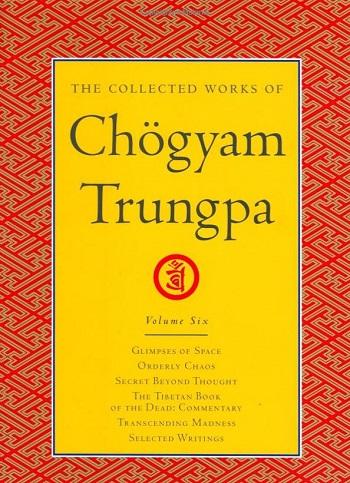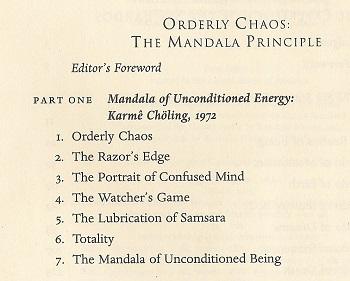The Razor’s Edge

Taken from

The Razor’s Edge
 he problem in discussing the idea of mandala seems to be that it is extraordinarily abstract. We see it as a metaphysical or philosophical principle, so we cannot learn anything about it unless some emphasis is made on a pragmatic way of looking at the idea of mandala. We have to have some working base or some way of identifying ourselves with the basic mandala principle. We have to see how the mandala principle is connected with a learning process or a practicing process. As has been said already, the only way to do that is to relate with the basic ground in which the mandala exists.
he problem in discussing the idea of mandala seems to be that it is extraordinarily abstract. We see it as a metaphysical or philosophical principle, so we cannot learn anything about it unless some emphasis is made on a pragmatic way of looking at the idea of mandala. We have to have some working base or some way of identifying ourselves with the basic mandala principle. We have to see how the mandala principle is connected with a learning process or a practicing process. As has been said already, the only way to do that is to relate with the basic ground in which the mandala exists.
The word mandala literally means “association,” “society.” The Tibetan word for mandala is kyilkhor. Kyil means “center,” khor means “fringe,” “gestalt,” “area around.” It is a way of looking at situations in terms of relativity: if that exists, this exists; if this exists, that exists. Things exist interdependently, and that interdependent existence of things happens in the fashion of orderly chaos.
We have all kinds of orderly chaos. We have domestic orderly chaos and we have the emotional orderly chaos of a love affair. We have spiritual orderly chaos, and even the attainment of enlightenment has an orderly chaos of its own. So it is a question of relating with different types of orderly chaos.
But before discussing the idea of orderly chaos itself, we have to discuss the basic area in which orderly chaos happens. Before we realize something is orderly and before we realize that it is chaos, there is some basic ground on which that chaos is constantly happening in an orderly fashion, in accordance with its own pattern. This ground is what we are concerned with now in our discussion of mandala. Seeing the ground is connected with how we can wake ourselves up, how we practice, how we relate with the day-to-day situation.
I would like to repeat and make very clear that we cannot discuss the higher mandala principle until we have some realization concerning the samsaric or confused mandala, the confused level of orderly chaos. The basic situation is that we are involved in a sense of struggle in our lives. We are trying to defeat somebody or win somebody over, to get rid of an enemy or acknowledge a friend. Whether we live in the city or in the country, we are trying either to fight with our environment or to indulge in it.
There are all kinds of areas where we are constantly involved with picking and choosing. That is the basic area where the orderly chaos is taking place. Spirituality, from a superficial point of view, is based on the idea of making things harmonious. But somehow, from the point of view of the mandala principle, that approach does not apply. The idea is not so much to make things harmonious and less active, but to relate with what is happening, with whatever struggles and upheavals are going on—trying to survive, to earn more dollars, get more food, more room, more space, a roof over our heads, and so on. If we are living in the city or certain areas in the suburbs, it could be extraordinarily oppressive. Possibilities of rape and murder are taken for granted, and things seem to happen of their own accord. We never know what is the beginning, what is the end, or how to proceed.
As soon as we wake up in the morning, we find that we are ready to fight the world. Having breakfast is a preparation, like taking a magic potion so that we can fight the world. And after having breakfast, we go out and fight the world. There is something interesting and very beautiful about the simplicity of preparing for warfare and then beginning to fight. We either expect to be attacked and defend ourselves or to attack somebody else and have them defend themselves. So we are going to have an encounter that is based on struggle. No matter what our particular mentality is, the total picture is one of struggle—fight, gain, and loss. That kind of basic mentality exists whether we live in a town or in the country. That mentality goes on constantly. The sense of the total environment is one of abstract struggle.
It is not struggle for something particular or on behalf of a particular syndicate or anything like that; rather there is a total sense of imprisonment. There is a sense that the world has captured us and we have to live with it, we have to fight it as though we were behind iron bars. The sense of imprisonment is always there. That is the basic ground of the mandala, before orderly chaos begins to happen.
There is that total area of depression or excitement, of expressing richness or poverty; something is holding us to that particular place. That fundamental totality of grayness or black-and-whiteness—it depends on the individual—is interesting, extraordinarily beautiful, if 1 may use such a term. By beautiful, I do not mean something purely pleasurable; I am referring to the fact that the ground is extremely awake, alert. Everybody is alert, willing to fight, willing to attack, willing to make money, willing to struggle with the living situation in whatever way. There is that whole, total energy that we are involved with. There is constantly a sense that something is just about to take place. It is as though some underground gossip network had sent a message around, and everybody has decided to be prepared for the situation. The five- minute warning has already been given, all over the place. There is a kind of tentative flickering of positive and negative possibilities—possible chaos, possible gift of God. We can look at it from either side—possible excitement, possible depression. There is that flickering going on in the background of the whole situation.
The reason I am mentioning this is because that situation is not solid space. It is actual space, and we could feel a sense of “spaceness” all the time. There is some element of free will always there. Even if we feel trapped or compelled to do certain things, nevertheless we feel that the decision and the spaciousness—this sense of space, this sense that something is taking place—belongs to us. Of course, this is a very abstract point, very difficult to grasp.
That total energy—totally creative, totally
destructive—is what one might call nowness. Nowness is the sense that we are attuned to what is happening. The past is fiction and the future is a dream, and we are just living on the edge of a razor blade. It is extraordinarily sharp, extraordinarily tentative and quivering. We try to establish ground but the ground is not solid enough, because it is too sharp. We are quivering between that and this.
Living on the razor blade means at the same time living in the total space, because the possibility exists that it might cut us through, destroy us, and the possibility also exists that we might be able to avoid the razor’s cut. But both those possibilities amount to the same thing at this point. The sense of the razor blade’s sharpness is very interesting, extraordinarily interesting. That is what we call intelligence, primordial intelligence. We feel that razor blade’s sharpness and its cutting quality. We sense that, we feel it, and we also want to run away from it. We would rather sit or perch on something more solid, like a toilet seat, some place where there’s no razor blade. But when we are on the razor blade, such an invitation becomes a fantasy. That is our basic intelligence beginning to sense all kinds of areas that are impossible but still somehow possible at the same time. This happens all the time.
It could actually be said to be a gift of God that we have not been presented with a comfortable toilet seat to perch on. Instead we’ve been presented with a razor blade for a seat. You never perch on a razor blade, you just be on it with attentiveness. The razor blade is an expression of the space of all the other areas. It could be that the rest of the areas are threatening and the razor blade is a comfortable space to sit on, or that the other areas are inviting and the razor blade is threatening. Whatever the case may be, there is that sense of being there fully, with nothing tentative about it at all. The whole thing becomes extremely powerful and spacious, and that is the enlightened or transcendental aspect of the mandala.
The enlightened aspect of the mandala and the samsaric, or whirlpool-like, aspect take place on the same razor blade. But actually there is not just one razor blade. The path is full of razor blades, to such an extent that we have nowhere to walk. We might wish for the yogic ability to levitate so that we could avoid these razor blades, but we find that we have not acquired that ability yet. If we had, then quite possibly there would be no razor blades there at all. Being able to levitate and there not being any razor blades amount to the same thing.
This razor-blade quality is something more than psychological irritation. Life as a whole becomes penetratingly sharp—unavoidable and at the same time cutting. We could say that that is the living description of the truth that life contains pain. According to Buddhism, life or existence is defined according to the truth of suffering, which is the razor blade. The truth of the origin of suffering is finding out that there is a razor blade. Then there is the truth of the goal, which is connected with seeing the razor blade as the path, or else diminishing the effect of the razor blade. But we cannot use magical powers at all. We have to face the reality in its fullest truthful nature, straightforwardly.